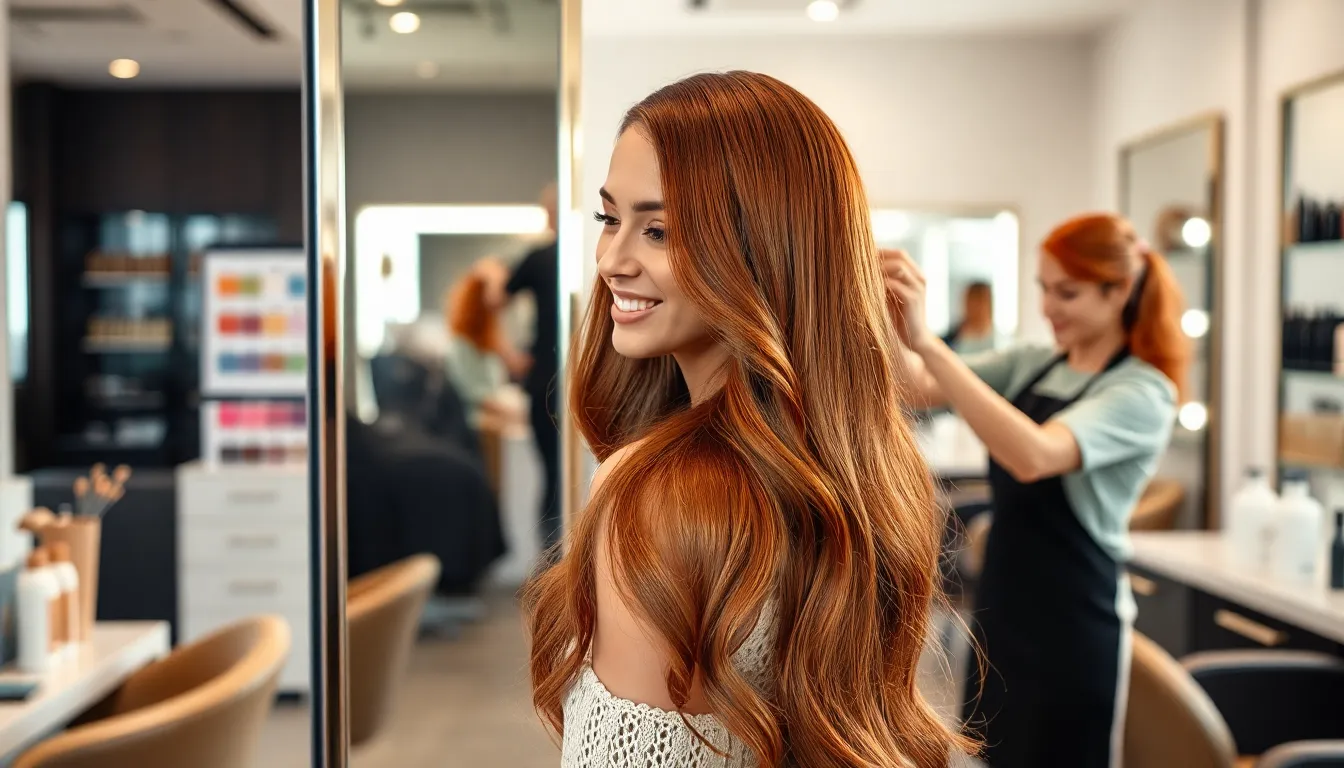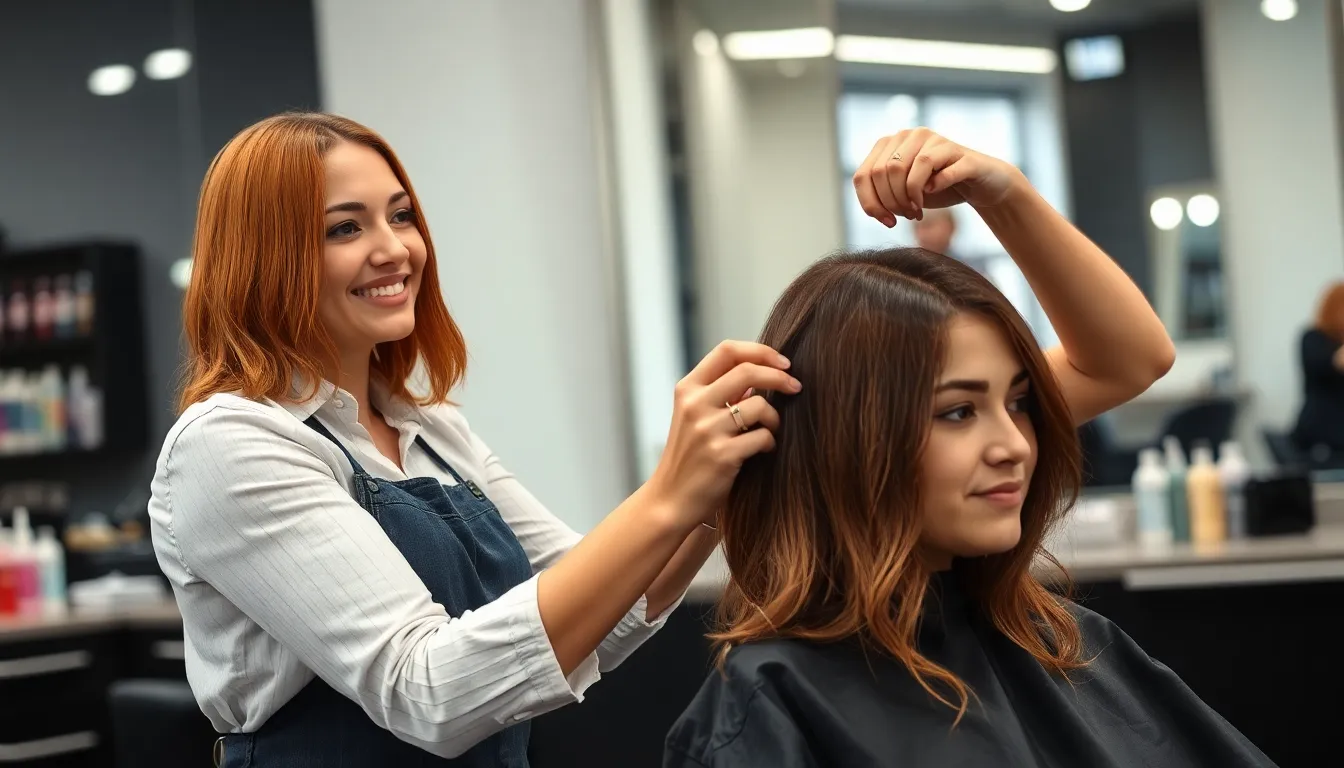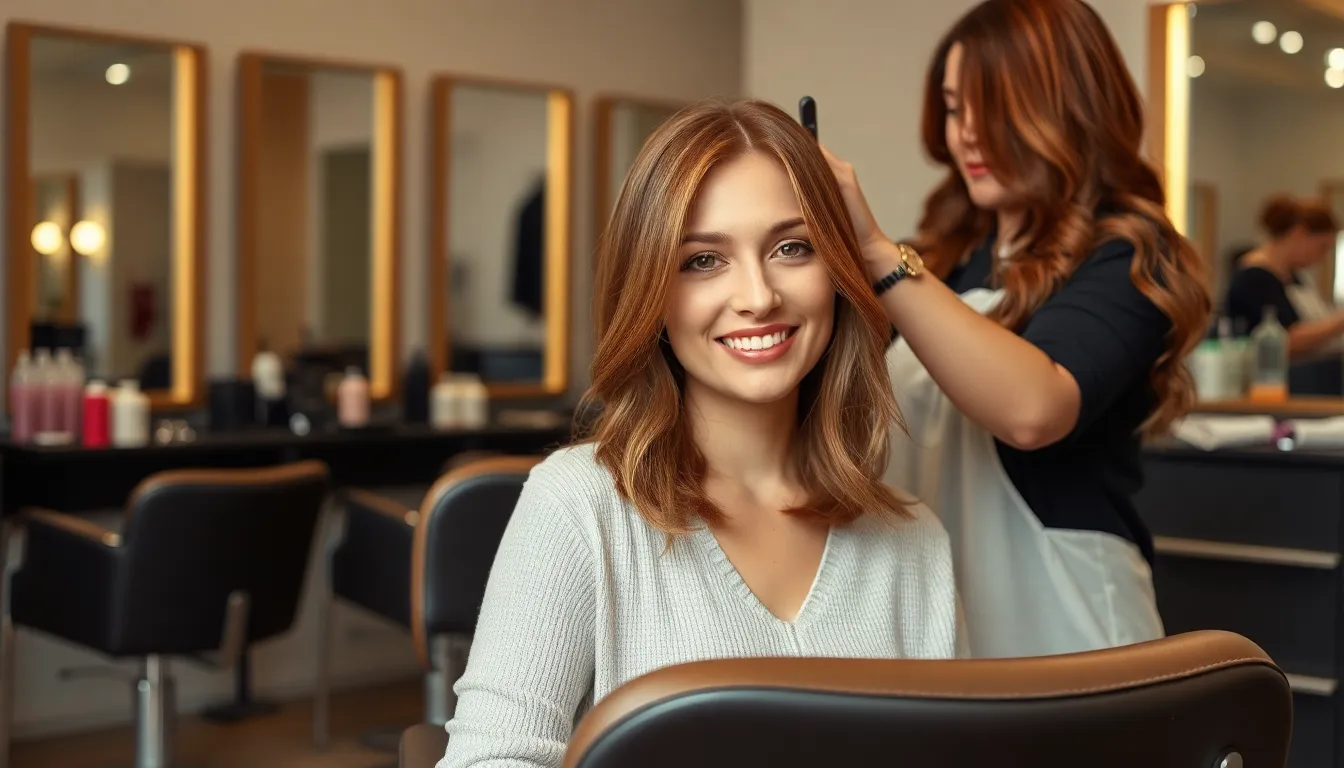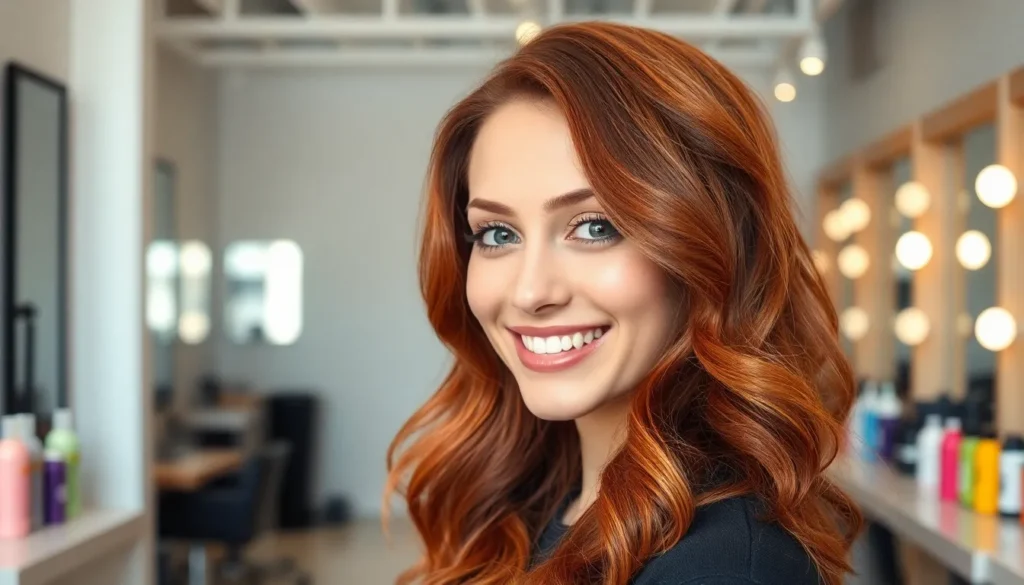We’ve all witnessed the captivating allure of copper hair color as it catches light and transforms into liquid fire. This stunning shade has emerged as one of 2025’s most coveted hair trends, blending the warmth of red with golden undertones that flatter virtually every skin tone.
Copper hair isn’t just another passing fad – it’s a statement color that radiates confidence and sophistication. From subtle strawberry copper highlights to bold penny-bright transformations, this versatile hue offers endless possibilities for personal expression. Whether you’re looking to make a dramatic change or simply add warmth to your existing color, copper delivers that perfect balance of edgy and elegant.
We’re here to guide you through everything you need to know about achieving and maintaining gorgeous copper locks. From choosing the right shade for your complexion to understanding the coloring process, we’ll help you make this fiery transformation with confidence.
Understanding Copper Hair Color: The Warm Metallic Trend
We’re diving deeper into what makes copper hair color such a distinctive and sought-after shade in today’s beauty industry.
What Makes Copper Hair Color Unique
Copper hair color stands out as a perfect fusion of red and orange undertones that creates a luminous metallic finish. This vibrant shade captures light differently than traditional reds or browns, producing a multidimensional effect that shifts from burnished bronze to bright penny copper depending on the lighting.
Versatility defines copper’s appeal across different hair textures and lengths. Fine hair gains incredible depth and richness, while thick hair showcases the color’s full metallic brilliance. Natural redheads often find copper enhances their existing tones, creating a more polished and intentional look.
Warmth radiates from copper hair in ways that complement various skin undertones. Golden and peach undertones in the skin harmonize beautifully with copper’s warm base, while neutral undertones can pull off both bright and muted copper variations.
Durability sets copper apart from other fashion colors since it fades gracefully into warm auburn and bronze tones. Unlike blues or purples that can fade to unflattering shades, copper maintains its appeal throughout the color cycle.
The Science Behind Copper Hair Pigments
Copper hair pigments rely on exact combinations of red and yellow artificial colorants to achieve their metallic appearance. Professional colorists typically use a base of red pigments (primarily 6.4 or 7.4 shades) mixed with golden tones to create the signature copper finish.
Melanin interaction plays a crucial role in how copper appears on different natural hair colors. Dark hair requires lightening to remove existing pigments before copper can fully develop, while lighter hair accepts copper tones more readily with less processing time.
Oxidation creates the metallic sheen that makes copper hair so distinctive. When hair cuticles are properly opened during the coloring process, copper pigments penetrate deeper into the hair shaft, creating longer-lasting results and enhanced shine.
Temperature affects how copper pigments develop during processing. Warmer temperatures accelerate color development, while cooler temperatures allow for more controlled, gradual color saturation. Most copper formulations work optimally at room temperature for 25-35 minutes depending on desired intensity.
Alkaline environments help copper pigments bond effectively with hair proteins. Professional copper hair colors typically have a pH between 9.5-10.5, which opens the hair cuticle sufficiently for proper pigment penetration while minimizing excessive damage.
Choosing the Right Copper Hair Color Shade for Your Skin Tone

Finding your perfect copper shade requires understanding how different tones interact with your natural coloring. We’ll help you identify which copper variations will enhance your complexion most effectively.
Copper Shades for Warm Skin Undertones
Golden copper tones create stunning harmony with warm undertones in your skin. These rich, honeyed variations include burnt orange copper, amber copper, and golden penny shades that amplify your natural warmth. Warm undertones typically feature yellow, peach, or golden hues that make veins appear greenish on your wrist.
Burnished copper shades work exceptionally well if you have olive or golden brown skin. These deeper variations contain more orange pigments that complement the yellow undertones in your complexion. Consider auburn copper or mahogany copper for darker skin tones, as these shades provide enough contrast while maintaining warmth.
Strawberry copper offers a lighter option for fair skin with warm undertones. This delicate blend incorporates peachy pink elements that won’t overwhelm lighter complexions while still delivering that coveted metallic finish.
Copper Shades for Cool Skin Undertones
Rose copper variations complement cool undertones by incorporating pink and violet elements. These sophisticated shades include rose gold copper, dusty copper, and copper blonde that won’t clash with your skin’s natural coolness. Cool undertones typically display pink, red, or blue hues that make veins appear bluish or purple.
Muted copper tones work better than vibrant oranges for cool skin types. Opt for copper brown or mushroom copper that contain ashy elements to prevent the color from appearing too warm against your complexion. These subdued variations maintain copper’s metallic appeal while respecting your skin’s natural undertones.
Copper balayage techniques allow you to test cooler copper shades gradually. Start with subtle highlights around your face to see how the color interacts with your skin before committing to a full transformation.
Copper Shades for Neutral Skin Undertones
Balanced copper shades offer the most flexibility for neutral undertones since your skin doesn’t lean strongly warm or cool. Classic copper penny and traditional copper red work beautifully because they contain equal amounts of warm and cool elements. Neutral undertones typically make it difficult to determine whether your veins appear green or blue.
Versatile copper bronze provides an excellent middle ground that adapts to different lighting conditions. This shade shifts between warm and cool depending on your environment, making it perfect for neutral skin tones. Consider copper chestnut for a deeper option that maintains this adaptability.
Customized copper blends allow colorists to adjust the warmth or coolness based on your exact neutral undertones. Professional colorists can fine tune the formula by adding subtle golden or ashy elements to create your ideal copper shade.
Preparing Your Hair for Copper Hair Color Transformation

Transforming your hair to copper requires careful preparation to achieve vibrant, long-lasting results. We’ll guide you through each essential step to ensure your copper transformation exceeds expectations.
Assessing Your Current Hair Color and Condition
Evaluate your starting hair color first, as this determines the entire transformation process. Natural blonde hair typically accepts copper pigments most readily, requiring minimal lightening to achieve brilliant results. Brown hair needs moderate lightening to reach the necessary base level for copper vibrancy. Black or very dark hair presents the greatest challenge, often requiring multiple lightening sessions before copper application.
Check your hair’s porosity by performing a simple strand test with water. High porosity hair absorbs color quickly but may fade faster, while low porosity hair resists color penetration but holds pigment longer once processed. Medium porosity hair offers the ideal balance for copper color retention.
Examine your hair’s current condition by assessing elasticity, shine, and texture. Healthy hair stretches and returns to its original length when wet, while damaged hair breaks easily or feels rough to the touch. Previous chemical treatments like relaxers, perms, or bleaching affect how copper pigments will bond with your hair strands.
Document any previous color treatments you’ve had within the past six months. Box dyes, salon colors, and metallic-based products can interfere with copper application and cause unpredictable results. Professional colorists need this information to formulate the correct approach for your copper transformation.
Pre-Lightening Requirements for Darker Hair
Determine your target lightening level based on your desired copper shade intensity. Light copper shades require lifting hair to a level 7 or 8, while deeper copper tones work well on level 5 or 6 bases. Your colorist will assess how many lifting sessions your hair needs to reach the appropriate canvas for copper application.
Plan for multiple lightening sessions if your hair is naturally dark or previously colored. Gradual lightening preserves hair integrity better than attempting dramatic color changes in one session. Most dark hair requires 2-3 lightening appointments spaced 2-4 weeks apart for optimal results.
Choose professional bleaching products that offer controlled lifting power without excessive damage. Volume 20 developer works well for most initial lightening sessions, while volume 30 may be necessary for stubborn pigments. Your colorist will select appropriate products based on your hair’s unique characteristics and condition.
Expect some brassiness during the lightening process, as orange and yellow undertones naturally emerge when dark pigments are removed. This brassy base actually helps copper colors appear more vibrant and natural once applied over properly lightened hair.
Essential Hair Health Steps Before Coloring
Start deep conditioning treatments 2-3 weeks before your copper appointment to strengthen your hair’s structure. Protein treatments help rebuild damaged cuticles, while moisture masks restore elasticity and shine. We recommend alternating between protein and moisture treatments based on your hair’s exact needs.
Minimize heat styling in the weeks leading up to your copper transformation to prevent additional damage. Air dry your hair when possible, and use heat protectant products when styling tools are necessary. Healthy hair accepts copper pigments more evenly and maintains color vibrancy longer.
Trim damaged ends at least one week before coloring to remove split ends and create a fresh canvas. Damaged ends often grab color differently than healthy hair, leading to uneven copper results. A professional trim also ensures your new copper color looks polished and well-maintained.
Avoid clarifying shampoos and harsh cleansing products for one week before your appointment. These products can over-strip natural oils that help protect your scalp and hair during the coloring process. Gentle, sulfate-free shampoos maintain optimal hair condition without compromising your upcoming copper transformation.
Schedule your appointment strategically when your hair hasn’t been washed for 24-48 hours. Natural scalp oils provide protection during the coloring process, reducing potential irritation while helping copper pigments adhere more effectively to your hair strands.
Professional vs. At-Home Copper Hair Color Application

Choosing between professional salon services and DIY copper hair coloring significantly impacts your final results and hair health.
Benefits of Professional Copper Hair Coloring
Professional colorists possess advanced technical knowledge to create stunning copper transformations that match your unique features. Expert stylists evaluate your hair’s porosity, previous color treatments, and natural undertones to formulate custom copper blends that achieve optimal results. Salon grade products penetrate hair cuticles more effectively than box dyes, creating longer lasting color with enhanced vibrancy.
Advanced lightening techniques allow professionals to safely lift darker hair without causing excessive damage. Colorists use controlled bleaching processes that preserve hair integrity while creating the perfect canvas for copper pigments. Professional tools like foil highlighting and color melting create dimensional copper looks that appear naturally grown out.
Quality assurance comes standard with professional services, as experienced colorists can correct color mishaps immediately. Salon professionals monitor processing times precisely to prevent over development or uneven results. Many salons offer color guarantees and complimentary touch ups if the initial results don’t meet expectations.
Hair health monitoring throughout the coloring process ensures minimal damage to your strands. Professional deep conditioning treatments applied during and after coloring help maintain hair strength and moisture. Stylists can adjust formulations mid process if they notice adverse reactions or unexpected color development.
DIY Copper Hair Color Tips and Techniques
DIY copper coloring requires careful product selection and thorough preparation to achieve salon quality results at home. Box dyes labeled “copper” or “auburn” provide convenient options for those with light brown to medium blonde starting colors. Semi permanent copper tones offer gentler alternatives that fade gradually over 4 to 6 weeks.
Strand testing becomes crucial when attempting copper color at home to predict final results. Apply chosen color to a hidden section of hair 48 hours before full application to check for allergic reactions and color outcome. Document the processing time and final shade to replicate successful results across your entire head.
Application techniques significantly impact the evenness of your copper color transformation. Section hair into four quadrants and apply color from mid length to ends first, then work toward roots for uniform coverage. Use a wide tooth comb to distribute product evenly through each section, preventing streaky or patchy results.
Timing precision prevents over processing that can lead to orange or brassy tones instead of rich copper hues. Follow package instructions exactly and set multiple timers to track processing time accurately. Rinse thoroughly with cool water when time expires to stop the chemical process immediately.
Color maintenance products extend the life of DIY copper hair color between applications. Sulfate free shampoos preserve color molecules while copper improving conditioners add shine and vibrancy. Weekly deep conditioning masks prevent dryness that can cause premature color fading.
Cost Comparison and Time Investment
Professional copper hair coloring typically costs between $150 to $400 depending on hair length, complexity, and salon location. Full copper transformations requiring multiple lightening sessions can reach $500 or more for dramatic color changes. Maintenance appointments every 6 to 8 weeks add $100 to $200 to your ongoing hair budget.
DIY copper coloring materials cost significantly less, ranging from $15 to $50 for complete home kits. Quality semi permanent copper dyes average $25 to $35 per application, while permanent options cost $20 to $45 including developer. Additional tools like gloves, brushes, and conditioning treatments add $20 to $30 to initial investment.
Time investment varies dramatically between professional and at home applications. Salon appointments for copper color typically require 3 to 6 hours depending on starting hair color and desired intensity. Complex transformations involving multiple processes can extend to 8 hours or require split appointments.
Home coloring sessions generally take 2 to 4 hours from start to finish including preparation and cleanup. DIY applications require additional research time to understand proper techniques and product selection. Correction appointments become necessary if home coloring results disappoint, potentially doubling your total time and cost investment.
| Application Method | Initial Cost | Maintenance Cost | Time Required | Success Rate |
|---|---|---|---|---|
| Professional Salon | $150-$400 | $100-$200 every 6-8 weeks | 3-8 hours | 90-95% |
| DIY Home Kit | $15-$50 | $15-$35 every 4-6 weeks | 2-4 hours | 60-75% |
Maintaining Your Copper Hair Color Vibrancy

Copper hair color requires exact care to preserve its brilliant metallic shine and prevent fading. We’ll explore the essential maintenance strategies that keep your copper tones looking fresh and vibrant.
Color-Safe Shampoo and Conditioner Selection
Sulfate-free formulas protect copper pigments from premature fading by maintaining gentle cleansing without stripping essential color molecules. Color-depositing shampoos specifically designed for red and copper tones refresh your hue between salon visits while preserving the dimensional metallic finish.
pH-balanced products between 4.5 and 5.5 seal the hair cuticle and lock in copper pigments more effectively. Moisturizing conditioners with UV protection shield your hair from environmental factors that cause color degradation and brassiness.
Weekly deep conditioning treatments restore moisture and strengthen the hair shaft damaged during the coloring process. Purple shampoo once per week neutralizes unwanted yellow tones that can muddy your copper’s brilliant clarity, while protein treatments maintain hair integrity for longer-lasting color retention.
Heat Protection and Styling Considerations
Thermal protection sprays with heat resistance up to 450°F create a barrier between your copper hair and styling tools to prevent color fade and damage. Lower temperature settings between 250-300°F achieve styling results while minimizing heat-induced color loss and maintaining copper’s metallic luster.
Air drying techniques preserve copper vibrancy by reducing heat exposure that breaks down color molecules. Microfiber towels and cotton t-shirts prevent roughening the hair cuticle during the drying process, keeping copper tones smooth and reflective.
Ceramic or tourmaline styling tools distribute heat more evenly and generate negative ions that seal the hair cuticle for enhanced color protection. Cool shot settings on blow dryers lock in styles while closing the cuticle to trap copper pigments inside the hair shaft.
Touch-Up Timeline and Root Maintenance
Root touch-ups every 4-6 weeks maintain seamless color transitions as natural hair growth reveals your base color underneath the copper transformation. Professional colorists match your existing copper shade precisely to avoid color bands or uneven toning.
Gloss treatments every 6-8 weeks refresh copper’s metallic shine and add dimensional depth that fades naturally over time. Semi-permanent color refreshers extend the vibrancy between full color services while depositing copper tones that enhance your hair’s natural luminosity.
Color-improving masks applied monthly restore copper pigments and repair damage from environmental exposure and daily styling routines. Scheduling maintenance appointments before important fading occurs prevents the need for complete recoloring and maintains consistent copper brilliance throughout the year.
Styling Copper Hair Color for Maximum Impact

The vibrant metallic finish of copper hair color provides endless styling opportunities that enhance its natural warmth and brilliance. Maximizing copper’s visual impact involves coordinating makeup choices, wardrobe selections, and seasonal adaptations that complement this stunning hair transformation.
Makeup Colors That Complement Copper Hair
Warm earth tones create the most flattering makeup combinations with copper hair, emphasizing the golden and red undertones naturally present in this metallic shade. Bronze eyeshadows and copper-toned highlights enhance the hair’s natural warmth while creating a cohesive look that ties your entire appearance together.
Berry lipsticks in deep plum and burgundy shades provide striking contrast against copper hair, making both the hair color and lip color appear more vibrant. Coral and peach lip colors offer softer alternatives that maintain warmth while creating a fresh, natural appearance perfect for daytime wear.
Golden highlighters and bronzers amplify copper hair’s luminous quality by reflecting similar metallic undertones across your complexion. Cream blushes in warm apricot and terracotta tones blend seamlessly with copper’s warmth, creating dimension and natural-looking color that enhances your overall glow.
Green eyeshadows create dramatic contrast with copper hair, making the red undertones appear more intense and eye-catching. Emerald and forest green shades work particularly well for evening looks, while softer sage and olive greens provide subtle contrast for everyday wear.
Fashion and Wardrobe Choices for Copper Hair
Emerald green clothing creates stunning visual contrast with copper hair, making both colors appear more saturated and vibrant. Navy blue garments provide sophisticated contrast that allows copper tones to shine without overwhelming the overall look, particularly effective in professional settings.
Cream and ivory colors offer elegant neutrals that highlight copper hair’s warmth without competing for attention. These soft tones create timeless combinations perfect for both casual and formal occasions, allowing your hair color to remain the focal point of your style.
Rich jewel tones like sapphire blue and deep purple complement copper hair’s intensity while creating luxurious color combinations. Burgundy and wine-colored clothing echo the red undertones in copper hair, creating monochromatic looks that appear intentionally coordinated and sophisticated.
Camel and tan accessories work beautifully with copper hair, creating warm color palettes that feel cohesive and naturally harmonious. Gold jewelry enhances copper’s metallic qualities, while rose gold pieces bridge the gap between warm and cool tones for versatile styling options.
Seasonal Styling Variations
Spring styling emphasizes copper hair’s golden undertones with fresh makeup looks featuring peachy blushes and coral lipsticks. Light, flowing fabrics in cream and soft green tones complement the season’s renewal energy while highlighting your hair’s natural luminosity and warmth.
Summer approaches call for bronzed makeup looks that match copper hair’s sun-kissed appearance with golden eyeshadows and warm-toned highlighters. Lightweight clothing in emerald and navy creates cooling contrast while maintaining the sophisticated appeal that copper hair demands.
Autumn naturally showcases copper hair color through rich, earth-toned makeup featuring burnt orange eyeshadows and berry lipsticks. Wardrobe choices in burgundy, forest green, and warm brown create perfect seasonal coordination that celebrates copper’s natural autumnal associations.
Winter styling intensifies copper hair’s drama with deeper makeup tones including plum lipsticks and bronze eyeshadows with metallic finishes. Luxurious fabrics in jewel tones and classic neutrals provide elegant backdrops that allow copper hair to shine against winter’s muted natural palette.
Troubleshooting Common Copper Hair Color Issues

Even with careful preparation and application, copper hair color can present unique challenges that require exact answers. We’ll address the most common issues and provide proven techniques to restore your copper’s metallic brilliance.
Dealing with Unwanted Brassiness
Brassiness occurs when copper hair develops orange or yellow tones that overpower the intended metallic finish. Purple shampoo becomes your primary weapon against unwanted warm tones, neutralizing excessive orange pigments through color theory principles. Use purple shampoo once or twice weekly, leaving it on damp hair for 3-5 minutes before rinsing thoroughly.
Toning treatments provide more intensive correction for stubborn brassy areas. Professional colorists can apply custom toners that specifically target orange undertones while preserving copper’s natural warmth. Schedule toning appointments every 6-8 weeks to maintain optimal color balance and prevent brassiness from developing.
Water quality significantly impacts copper hair’s tendency toward brassiness. Hard water minerals like iron and copper deposits can intensify unwanted orange tones over time. Install a shower filter or use chelating shampoos weekly to remove mineral buildup that contributes to color distortion.
Fixing Uneven Color Results
Uneven copper color typically results from inconsistent application or varying hair porosity across different sections. Strand testing reveals porosity differences before full application, allowing you to adjust processing times for different hair areas. Apply color to porous sections last since they absorb pigment faster than healthy hair.
Professional color correction requires strategic placement of additional copper tones to balance patchy areas. Colorists use foil techniques to isolate uneven sections and apply targeted formulations that match surrounding hair. This process may require multiple sessions spaced 2-3 weeks apart to prevent over processing.
Home correction attempts should focus on gradual improvement rather than dramatic changes. Semi permanent copper glosses can help even out minor color variations without causing additional damage. Apply gloss treatments every 4-6 weeks to build consistent color depth across all hair sections.
Managing Color Fading and Dullness
Color fading occurs naturally as copper pigments wash out with each shampoo cycle. Reduce washing frequency to 2-3 times weekly using lukewarm water to minimize pigment loss. Cold water final rinses seal the hair cuticle and lock in copper molecules for extended color longevity.
UV exposure accelerates copper color fading and creates dull, lifeless tones. Wear UV protective hair products when spending time outdoors, and consider protective styling like braids or updos during peak sun hours. Reapply UV sprays every 2-3 hours during extended outdoor activities.
Refreshing treatments restore copper’s metallic shine between full color appointments. Color depositing conditioners add subtle copper pigments during your regular conditioning routine. Professional gloss treatments provide more dramatic refresh results, restoring depth and dimension to faded copper hair every 4-6 weeks.
Heat styling without protection strips copper pigments and creates dry, dull hair texture. Apply thermal protection products before using any heated tools, and keep temperatures below 350°F to preserve color integrity. Air drying whenever possible extends copper color vibrancy and maintains hair health.
Transitioning Out of Copper Hair Color Gracefully

Transitioning away from copper hair requires patience and strategic planning to avoid damaging your hair. We’ll guide you through gentle methods that preserve hair health while achieving your desired new look.
Growing Out Copper Hair Color Naturally
Growing out copper hair naturally offers the gentlest approach to color transition. Your natural root growth creates a gradual shift that minimizes harsh lines and reduces processing damage. We recommend embracing root shadows and color melting techniques during this phase to blend the transition seamlessly.
Blending techniques help disguise the growing-out process effectively. Professional colorists can add lowlights that match your natural color while gradually toning down the copper intensity. These subtle additions create dimension and make the regrowth less noticeable as it progresses.
Root concealing products provide temporary answers between salon visits. Color-matched root sprays and powders can camouflage regrowth for up to 4-6 weeks. We suggest applying these products sparingly on clean, dry hair for the most natural appearance.
Strategic haircuts accelerate the natural transition timeline. Regular trims every 8-10 weeks gradually remove colored sections while maintaining healthy hair integrity. Shorter styles naturally reduce the overall transition time compared to longer lengths.
Protective styling minimizes color contrast during the growing-out phase. Braids, updos, and textured styles help blend different color zones while protecting hair from environmental damage. These styling options work particularly well when copper roots are 2-3 inches long.
Color Correction Options and Techniques
Color correction provides professional answers for immediate copper removal. Colorists use specialized techniques like color stripping or bleaching to lift copper pigments safely. These processes typically require 2-3 hours and may need multiple sessions for complete removal.
Toning treatments neutralize unwanted copper undertones effectively. Professional toners containing blue and green bases counteract orange and red pigments in copper hair. We recommend scheduling toning sessions 4-6 weeks apart to maintain neutral results.
Gradual lightening preserves hair integrity during correction processes. Step-by-step lifting techniques remove copper pigments in stages rather than aggressive single-session processing. This method reduces breakage risk while achieving desired lightness levels.
Color depositing treatments add new pigments over existing copper tones. Darker shades like chocolate brown or espresso can cover copper effectively with minimal lightening required. These overlay techniques work best when moving to colors 2-3 shades darker than current copper.
Professional assessment determines the safest correction approach. Colorists evaluate hair porosity, previous processing history, and current condition before selecting appropriate techniques. This consultation prevents over-processing and ensures optimal results.
Timeline for Complete Color Change
| Transition Method | Timeline | Sessions Required | Hair Health Impact |
|---|---|---|---|
| Natural Growth | 8-12 months | 3-4 maintenance visits | Minimal damage |
| Gradual Color Correction | 3-6 months | 2-4 professional sessions | Moderate processing |
| Complete Color Stripping | 1-2 months | 1-2 intensive sessions | Higher damage risk |
| Overlay Darkening | 1 session | Single appointment | Low to minimal impact |
Complete natural transition requires 8-12 months for shoulder-length hair. The average hair growth rate of 0.5 inches per month determines this timeline. Longer hair naturally extends the transition period to 12-18 months.
Professional color correction accelerates the process to 3-6 months. Multiple toning and lightening sessions gradually remove copper pigments while maintaining hair health. We space these appointments 6-8 weeks apart for optimal recovery.
Immediate color changes require intensive single-session processing. Complete color stripping followed by new color application can achieve dramatic results in one appointment. But, this approach carries higher risks of damage and may require extensive conditioning treatments.
Maintenance appointments every 4-6 weeks ensure smooth transitions. Regular touch-ups address regrowth, refresh toning, and maintain color consistency throughout the change process. These sessions also allow professionals to monitor hair health and adjust techniques as needed.
Hair length significantly impacts overall transition timelines. Pixie cuts may achieve complete color change in 4-6 months through natural growth and strategic cutting. Bob-length styles typically require 6-8 months, while longer styles need 12+ months for full transition.
Conclusion
Copper hair color offers an extraordinary way to transform your look with its stunning blend of warmth and sophistication. We’ve explored how this versatile shade adapts beautifully to different skin tones and hair types while creating that coveted multidimensional metallic finish.
Whether you’re considering a subtle copper highlight or a dramatic full transformation the key lies in proper preparation and professional guidance. Remember that maintaining your copper’s vibrancy requires dedicated care with the right products and regular touch-ups.
From achieving the perfect shade to gracefully transitioning away when you’re ready for change copper hair empowers you to express your unique style. With the knowledge we’ve shared you’re equipped to make informed decisions about this captivating color choice and enjoy stunning results that turn heads wherever you go.
Frequently Asked Questions
What makes copper hair color unique compared to other red shades?
Copper hair color stands out due to its perfect fusion of red and orange undertones that create a luminous metallic finish. Unlike traditional red hair colors, copper captures and reflects light differently, producing a multidimensional effect that shifts with various lighting conditions. This vibrant shade offers depth and richness while maintaining a sophisticated, warm appearance that complements many skin tones.
Is copper hair color suitable for all skin tones?
Yes, copper hair color can work for various skin tones when the right shade is selected. Warm undertones pair beautifully with golden copper and burnt orange shades, while cool undertones benefit from rose copper variations and muted copper brown tones. Those with neutral undertones can wear classic copper penny or versatile copper bronze shades that adapt to different lighting conditions.
How do I prepare my hair for copper coloring?
Preparation involves assessing your current hair color and condition, as darker hair may require multiple lightening sessions. Focus on improving hair health through deep conditioning treatments, minimizing heat styling, and avoiding harsh cleansing products before your appointment. Schedule a professional trim to remove damaged ends and document any previous color treatments that could affect the coloring process.
Should I get copper hair color professionally done or DIY?
Professional application is recommended for optimal results, offering advanced techniques, custom color blends, and superior product quality that leads to longer-lasting color. Professionals can monitor the process to ensure hair health and proper color development. While DIY options exist and may be more budget-friendly, professional services typically yield higher success rates and better color consistency.
How do I maintain copper hair color vibrancy?
Use sulfate-free, pH-balanced shampoos and conditioners specifically designed for color-treated hair. Incorporate weekly deep conditioning treatments and always apply thermal protection sprays before heat styling. Schedule regular touch-ups for root maintenance and gloss treatments to refresh the metallic shine. Avoid excessive sun exposure and chlorinated water, which can cause color fade.
How long does copper hair color typically last?
Copper hair color generally lasts 6-8 weeks before requiring touch-ups, depending on hair porosity, maintenance routine, and lifestyle factors. The metallic pigments may fade gradually, shifting to warmer tones over time. Regular gloss treatments every 4-6 weeks can help maintain vibrancy and extend the color’s lifespan between major touch-up appointments.
Can I transition away from copper hair color easily?
Transitioning from copper requires patience and strategic planning to avoid hair damage. You can grow it out naturally using blending techniques and root concealing products, or opt for professional color correction services. The transition timeline varies from 3-6 months for natural growth to 2-3 sessions for complete color change, depending on your desired end result.







